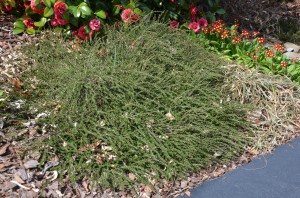The world of cotoneasters (Cotoneaster spp.) is primarily an assortment of medium to tall growing shrubs. Cotoneaster ‘Tom Thumb’ (syn. C. ‘Little Gem’) is very different. Its diminutive size fits into those small spots such as a rock garden or among dwarf conifers. Its dark green shiny foliage creates a textural contrast with many annuals or perennials.
Slow-growing ‘Tom Thumb’ may achieve 6 to 12 inches in height and 3 to 6 feet in width over 10-12 years. It hugs the ground, and often self-roots. It may be utilized as a deciduous ground cover, although this may be expensive option. Slightly taller bearberry (C. dammeri) or cranberry (C. apiculatus) cotoneasters are cheaper ground cover alternatives.
Its tiny spring flowers are mostly inconspicuous. Fruit numbers in the fall is never plentiful and have little ornamental value. In the autumn foliage turns bronzy red and is rarely an attention grabber. (USDA hardiness zones 5–7).
A native of western China, most nursery catalogs classify Tom Thumb as a variety of C. horizontalis, but others place it with C. adpressus or C. apiculatus. ‘Tom Thumb’ thrives in full sun or partial shade, and most pests don’t seem to bother it. Tom Thumb is not fussy about soil as long as it is well-drained. This slow growing plant requires little or no pruning.
Many cotoneasters are susceptible to fire blight, a bacterial disease.


 Posted in
Posted in 
